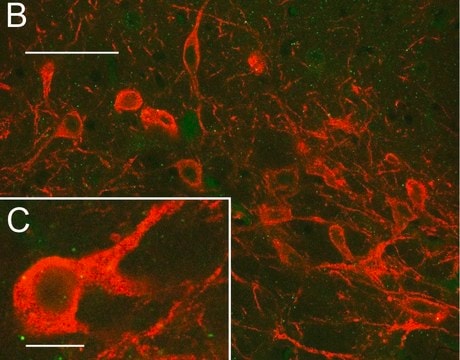PMEF-NL
EmbryoMax® Primary Mouse Embryonic Fibroblasts
Sinonimo/i:
MEF Feeder Cells, neo PMEFs, neo MEFs, MEFs, Mouse Feeder Cells
About This Item
Prodotti consigliati
Origine biologica
mouse
Livello qualitativo
Produttore/marchio commerciale
Specialty Media
EmbryoMax®
tecniche
cell culture | stem cell: suitable
input
sample type primary embryotic fibroblasts (PMEFs)
sample type induced pluripotent stem cell(s)
sample type: mouse embryonic stem cell(s)
Condizioni di spedizione
liquid nitrogen
Descrizione generale
Plating MEF Feeder Cells
Procedure:
1. Prior to thawing PMEF feeder cells, coat plates/flasks with Gelatin solution.
2. Thaw PMEF vial(s) quickly in a 37 °C water bath and transfer to a 15 mL tube (already containing 10 mL of warm PMEF Feeder Cell Medium). Gently invert the tube to distribute, and centrifuge at 300 xg for 4–5 minutes.
3. Remove supernatant and resuspend the cell pellet in warm PMEF Feeder Cell Medium.
4. Remove the Gelatin solution from plates/flasks, and aliquot the PMEF feeder cell suspension at the densities recommended in Table 4.1 of the mouse ES protocol guide
5. Incubate the PMEF Feeder cells at 37 °C with 5% CO2. Use Figures 4A, B and C in the mouse ES protocol guide as a guide for an estimate of correct PMEF density and
appearance. Gelatinized plates may be used for 12–14 days.
Descrizione della linea cellulare
Applicazioni
Confezionamento
Stato fisico
Stoccaggio e stabilità
Note legali
Codice della classe di stoccaggio
12 - Non Combustible Liquids
Punto d’infiammabilità (°F)
does not flash
Punto d’infiammabilità (°C)
does not flash
Certificati d'analisi (COA)
Cerca il Certificati d'analisi (COA) digitando il numero di lotto/batch corrispondente. I numeri di lotto o di batch sono stampati sull'etichetta dei prodotti dopo la parola ‘Lotto’ o ‘Batch’.
Possiedi già questo prodotto?
I documenti relativi ai prodotti acquistati recentemente sono disponibili nell’Archivio dei documenti.
Articoli
Mouse embryonic fibroblasts (MEFs) serve as a feeder layer for both mouse and human embryonic stem cells (ES cells) and induced pluripotent stem cells (iPSCs).
Protocolli
Stem Cell protocols for cryopreservation, thawing of cryopreserved stem cells and media preparation.
Il team dei nostri ricercatori vanta grande esperienza in tutte le aree della ricerca quali Life Science, scienza dei materiali, sintesi chimica, cromatografia, discipline analitiche, ecc..
Contatta l'Assistenza Tecnica.



